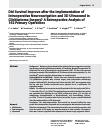Subscribe to RSS
DOI: 10.1055/s-0031-1297247
Did Survival Improve after the Implementation of Intraoperative Neuronavigation and 3D Ultrasound in Glioblastoma Surgery? A Retrospective Analysis of 192 Primary Operations
Publication History
Publication Date:
30 March 2012 (online)

Abstract
Background Numerous observational studies indicate that more aggressive resection may prolong survival in glioblastoma patients. In Trondheim, Norway, intraoperative 3D ultrasound has been in increasing use since November 1997. The aim of the present study was to examine if the introduction of 3D ultrasound and neuronavigation (i. e., the SonoWand® system) may have had an impact on overall survival.
Patients/Material and Methods Patient data were obtained retrospectively for the 192 glioblastoma patients who received surgery and postoperative radiotherapy between 1990 and 2005. Overall survival, before and after 1997, was compared using the log rank test. Possible confounders were adjusted for in a multivariate Cox regression analysis.
Results We observed an increase in survival for patients in the last study period (9.6 vs. 11.9 months; HR = 0.7; p = 0.034). The significant improvement in the latest time period was sustained after adjusting for age, WHO performance status (≥2) and type of radiotherapy (normofractioned or hypofractioned), and chemotherapy (yes/no), p = 0.034. 10 out of 14 patients who survived more than 3 years received treatment after the implementation of 3D ultrasound.
Conclusion Our study demonstrates that survival has improved within the same period that intraoperative ultrasound and neuronavigation was introduced and established in our department. The demonstrated association is a necessity for causation, but given the nature of this study, one must be cautious to claim causality. The improvement was, however, significant after adjustment for known major prognostic factors.
-
References
- 1 Stummer W, Pichlmeier U, Meinel T , et al. Fluorescence-guided surgery with 5-aminolevulinic acid for resection of malignant glioma: a randomised controlled multicentre phase III trial. Lancet Oncol 2006; 7: 392-401
- 2 Deorah S, Lynch CF, Sibenaller ZA , et al. Trends in brain cancer incidence and survival in the United States: Surveillance, Epidemiology, and End Results Program, 1973 to 2001. Neurosurg Focus 2006; 20: E1
- 3 Oertel J, von Buttlar E, Schroeder HW , et al. Prognosis of gliomas in the 1970s and today. Neurosurg Focus 2005; 18: e12
- 4 Kelly PJ. Technology in the resection of gliomas and the definition of madness. J Neurosurg 2004; 101: 284-286 ; discussion 286
- 5 Barker 2nd FG, Prados MD, Chang SM , et al. Radiation response and survival time in patients with glioblastoma multiforme. J Neurosurg 1996; 84: 442-448
- 6 Lacroix M, Abi-Said D, Fourney DR , et al. A multivariate analysis of 416 patients with glioblastoma multiforme: prognosis, extent of resection, and survival. J Neurosurg 2001; 95: 190-198
- 7 Stummer W, Novotny A, Stepp H , et al. Fluorescence-guided resection of glioblastoma multiforme by using 5-aminolevulinic acid-induced porphyrins: a prospective study in 52 consecutive patients. J Neurosurg 2000; 93: 1003-1013
- 8 Vecht CJ, Avezaat CJ, van Putten WL , et al. The influence of the extent of surgery on the neurological function and survival in malignant glioma. A retrospective analysis in 243 patients. J Neurol Neurosurg Psychiatry 1990; 53: 466-471
- 9 Simpson JR, Horton J, Scott C , et al. Influence of location and extent of surgical resection on survival of patients with glioblastoma multiforme: results of three consecutive Radiation Therapy Oncology Group (RTOG) clinical trials. Int J Radiat Oncol Biol Phys 1993; 26: 239-244
- 10 McGirt MJ, Chaichana KL, Gathinji M , et al. Independent association of extent of resection with survival in patients with malignant brain astrocytoma. J Neurosurg 2009; 110: 156-162
- 11 Albert FK, Forsting M, Sartor K , et al. Early postoperative magnetic resonance imaging after resection of malignant glioma: objective evaluation of residual tumor and its influence on regrowth and prognosis. Neurosurgery 1994; 34: 45-60 ; discussion 41–60
- 12 Vuorinen V, Hinkka S, Farkkila M , et al. Debulking or biopsy of malignant glioma in elderly people–a randomised study. Acta Neurochir (Wien) 2003; 145: 5-10
- 13 Stummer W, Reulen HJ, Meinel T , et al. Extent of resection and survival in glioblastoma multiforme: identification of and adjustment for bias. Neurosurgery 2008; 62: 564-576 ; discussion 564–576
- 14 Gronningsaeter A, Kleven A, Ommedal S , et al. SonoWand, an ultrasound-based neuronavigation system. Neurosurgery 2000; 47: 1373-1379 ; discussion 1379–1380
- 15 Unsgaard G, Ommedal S, Muller T , et al. Neuronavigation by intraoperative three-dimensional ultrasound: initial experience during brain tumor resection. Neurosurgery 2002; 50: 804-812 ; discussion 812
- 16 Solheim O, Selbekk T, Jakola AS , et al. Ultrasound-guided operations in unselected high-grade gliomas–overall results, impact of image quality and patient selection. Acta Neurochir (Wien) 2010; 152: 1873-1886
- 17 Stupp R, Mason WP, van den Bent MJ , et al. Radiotherapy plus concomitant and adjuvant temozolomide for glioblastoma. N Engl J Med 2005; 352: 987-996
- 18 Rygh OM, Selbekk T, Torp SH , et al. Comparison of navigated 3D ultrasound findings with histopathology in subsequent phases of glioblastoma resection. Acta Neurochir (Wien) 2008; 150: 1033-1041 ; discussion 1042
- 19 Kurimoto M, Hayashi N, Kamiyama H , et al. Impact of neuronavigation and image-guided extensive resection for adult patients with supratentorial malignant astrocytomas: a single-institution retrospective study. Minim Invasive Neurosurg 2004; 47: 278-283
- 20 Wirtz CR, Albert FK, Schwaderer M , et al. The benefit of neuronavigation for neurosurgery analyzed by its impact on glioblastoma surgery. Neurol Res 2000; 22: 354-360
- 21 Willems PW, Taphoorn MJ, Burger H , et al. Effectiveness of neuronavigation in resecting solitary intracerebral contrast-enhancing tumors: a randomized controlled trial. J Neurosurg 2006; 104: 360-368
- 22 Nazzaro JM, Neuwelt EA. The role of surgery in the management of supratentorial intermediate and high-grade astrocytomas in adults. J Neurosurg 1990; 73: 331-344
